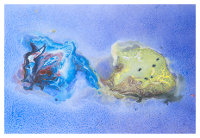Speaker
Oton Vazquez Doce
(Excellence Cluster Universe, TU-Munich.)
Description
The hyperon-pion and hyperon-nucleon(s) correlations following K- nuclear absorption in Helium and Carbon were investigated with the KLOE drift chamber and the results will be presented. To this end, KLOE [1] data (from 2004-2005) was analyzed using the detector itself as an active target. Also results from a more recent run (end of 2012) with a dedicated solid Carbon target will be presented.
The information extracted about the antikaon-nucleon potential is of great importance in the framework of the non-perturbative QCD in the strangeness sector, and the understanding of these processes has consequences that go from hadron and nuclear physics to astrophysics.
In particular, the debated resonance Lambda(1405) is investigated in the Sigma0 pi0 (a privileged, free of contamination from Sigma(1385), but still poorly explored channel [2]) and the Sigma+ pi- channels, generated by K- absorptions (at rest and with 120 MeV/c) on bound protons in 4He and 12C.
The Lambda(1405) is generally accepted to be a spin 1/2, I=0, S=-1 negative parity baryon resonance assigned to the lowest L=1 supermultiplet of the three-quark system, and decays only to Sigma-pi (I=0) through the strong interaction. Its nature still remains unsettled, in the meson-baryon picture it is viewed as a antikaon-nucleon quasi-bound I=0 [3], and in the context of chiral unitary models [4][5] two poles emerge in the scattering amplitude in the neighborhood of the Lambda(1405) mass, both contributing to the final experimental invariant mass.
The antikaon-nucleon potential is also investigated searching for signals from bound kaonic clusters (systems where a kaon is attached inside a nucleus [6]). The existence of such objects is very debated, and it would open the possibility for the formation of very dense baryonic matter and it would imply a deep attractive value for the potential. Results for the Lambda-proton, Lambda-deuteron and Lambda-triton correlations analyses will be presented.
[1] M. Adinolfi et al., Nucl. Instr. Meth. A 488, 51-73 (2002).
[2] K. Moriya, R. Schumacher, and CLAS Collaboration, AIP Conf. Proc. 1441, 296 (2012).
[3] R. H. Dalitz, T. C. Wong, G. Rajasekaran, Phys. Rev. 153, 1617 (1967).
[4] E. Oset, A. Ramos, Nuclear Phys. A 635,99 (1998).
[5] Y. Ikeda, T. Hyodo, W. Weise, Nucl. Phys. A 881, 98 (2012).
[6] Y. Akaishi and T. Yamazaki, Phys. Rev. C 65, 044005 (2002).
Author
Oton Vazquez Doce
(Excellence Cluster Universe, TU-Munich.)
